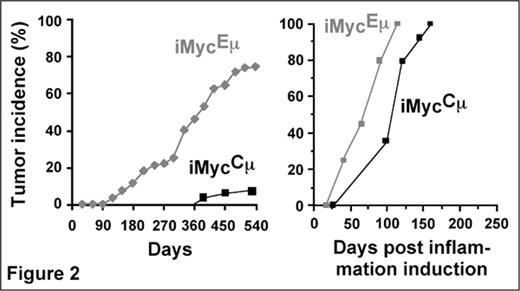Abstract
Purpose: Burkitt lymphoma (BL) is tightly associated with chromosomal t(8;14)(q24;q32) translocations that result in the deregulated expression of the MYC (c-myc) oncogene due to its juxtaposition to enhancers of the immunoglobulin-heavy chain locus IGH. The t(8;14)(q24;q32) MYC-IGH translocation is widely believed to be the initiating event in the pathogenesis of BL. Multiple myeloma (MM) is a malignant neoplasm of plasma cells that is often associated with complex cytogenetic alterations that juxtapose MYC, analogous to the t(8;14)(q24;q32) translocation, to IGH enhancers. However, MYC-IGH rearrangements of this sort occur during the progression of MM, not as tumor-initiating events as in BL. Accurate mouse models of MYC deregulation associated with human BL and MM are needed to study the events involved in tumor initiation and progression and design new approaches for treatment and prevention. To that end, we have generated a new mouse model of human t(8;14)(q24;q32) translocation.
Experimental procedure: We inserted a His6-tagged mouse Myc cDNA, MycHis, into two different locations of the mouse immunoglobulin heavy-chain locus, Igh, just 5′ of Eμ or Cμ. In the latter case, Eμ was deleted during gene targeting. The newly developed gene-insertion strains were designated iMycEμ and iMycCμ. The iMycEμ mice provide a specific model of the t(8;14)(q24;q32) observed in endemic BL (eBL). The iMycCμ mice mimic the t(8;14)(q24;q32) found in sporadic BL (sBL) and immunodeficiency-associated BL (iBL) (Fig. 1).
Result: Both “iMyc” gene-insertion strains are prone to the spontaneous development of mature B cell and plasma cell tumors. However, in the Eμ-containing iMycEμ mice, tumors arose earlier and tumor incidence was higher compared to the Eμ-deleted iMycCμ (Fig. 2 left).
This correlated well with the control of MycHis expression by Eμ, as MycHis mRNA levels were higher in B cells from iMycEμ than iMycCμ mice. Interestingly, the iMycCμ transgene was as effective in inducing inflammation-dependent peritoneal plasmacytomas as the iMycCμ transgene (Fig. 2 right). This indicated that host factors, such as chronic inflammation, can greatly enhance the transformation-inducing potency of a deregulated Myc gene that is only weakly oncogenic in spontaneous tumor development.
Conclusion: The “iMyc” mice provide a model of Myc deregulation that is conducive to plasma cell tumors in mice. The mice may thus afford a good opportunity to identify the genes that collaborate with Myc in neoplastic plasma cell development. Combined with the transgenic expression of MM genes, such as DKK1, the “iMyc” mice may also be useful as a platform for modelling human plasma cell neoplasms in mice.
Author notes
Corresponding author



This feature is available to Subscribers Only
Sign In or Create an Account Close Modal